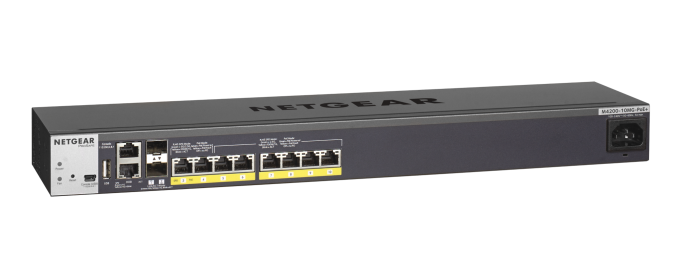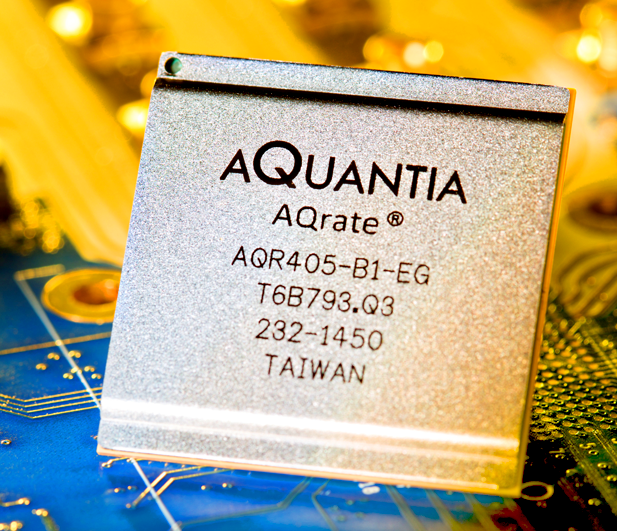NBASE-T Alliance Receives Boost with IEEE P802.3bz Approval for 2.5G/5G Ethernet
by Ganesh T S on October 3, 2016 8:00 AM EST- Posted in
- Networking
- 10GBase-T
- NBASE-T

Wired networks relying on traditional Cat 5e and Cat 6 cables (at their maximum channel length of 100m) have been limited to 1 Gbps so far. At the other end of the spectrum, 10 Gbps required augmented cables (Cat 6A or better) for transmission lengths typical in enterprise and business scenarios. Despite 10 Gbps Ethernet having been around for more than 10 years now, cost and power consumption aspects have limited its adoption on a wider basis. The NBASE-T Alliance was created to bring in support for speeds between 1 and 10 Gbps, while retaining the use of existing cabling infrastructure.
NBASE-T has become popular because it can act as an effective wired backhaul for 802.11ac wireless access points. With theoretical speeds exceeding 1 Gbps, the time and environment are right for technology that can replace the existing 1 Gbps network ports. 10GBASE-T is not really an effective solution because of the cost as well as power requirements aspect. Almost all enterprise access points are powered using Power over Ethernet (PoE). The IEEE 802.3af-2003 standard allows for up to 15.4 W (12.95 W assured), while PoE+ (IEEE 802.3at-2009) can provide up to 25.5 W. However, the 10GBASE-T standard doesn't currently support Power over Ethernet, even though it is being considered. Therefore, 10GBASE-T has not turned out to be an effective and universal solution to this challenge despite the bandwidth availability. This is where the 2.5 Gbps and 5 Gbps options provided by NBASE-T equipment become attractive. Some NBASE-T switches already implement PoE / PoE+, and are effective solutions for driving compatible 802.11ac wireless access points.
Netgear's M4200-10MG-PoE+ Managed Intelligent Edge Series Switch with 5G/2.5G Switching for High-Speed Wave 2 802.11ac Deployments
On September 23, 2016, the IEEE P 802.3bz 2.4G/5GBASE-T Task Force (which started work in March 2015) ratified the IEEE P802.3bz Standard for Ethernet Amendment: Media Access Control Parameters, Physical Layers and Management Parameters for 2.5 Gb/s and 5 Gb/s Operation. It allows 2.5 Gbps operation over standard Cat 5e cables, 5 Gbps over Cat 6, and 5 Gbps over Cat 5e under select conditions. All of these are up to at least 100m channel lengths.
The AQrate Family of NBASE-T PHYs from AQUANTIA - One of the Leading Market Players
The ratification is a big boost for the NBASE-T Alliance. The standardization also lends more credence to the NBASE-T plugfests scheduled to be conducted in October 2016. It will also bring more 2.5G/5GBASE-T products into the market, bring prices down and drive up adoption. The most important aspect is that the existing cabling infrastructure doesn't need a overhaul. This makes it very attractive for business and enterprise users.
From a power user / enthusiast viewpoint, NBASE-T equipment will be a good upgrade. However, readers planning on wiring up their homes would do well to go with Cat 6a cables for future-proofing purposes. 10GBASE-T products (both switches and motherboards / PCIe cards) for enthusiasts are already in the market, thanks to vendors like Asus. NBASE-T adoption will mainly be dictated by business and enterprise users in the near future. As local bandwidth requirements increase in the premises of the average consumer, 2.5G/5GBASE-T will surely find its way into networking gear for traditional consumers also.
Source: NBASE-T Alliance












37 Comments
View All Comments
azazel1024 - Tuesday, October 4, 2016 - link
It is all about tiered wireless performance. 60GHz can easily support performance up in to the dozens of Gbps ACTUAL transfer speeds. The issue is, it is effectively line of sight and by that I mean, don't accidently cover the antenna with your hand on your device or walk between your device and the access point. It can work on multipath/reflection, but still much slower than LoS.5Ghz can accommodate some pretty ridiculous speeds with MIMO, high character sets (like 1024QAM) and wide frequency (like 160MHz channels). That is a combination of wave 2 802.11ac and "next gen" 802.11ax. In theory you can hit 10Gbps with 802.11ax with IIRC 4 streams...which you'll never see in a laptop even.
But that is the kind of performance you might expect, again, in the same room. 5GHz doesn't go far though, so even in an urban environment there isn't going to be much stepping on your neighbors. But figure 802.11ax with a laptop might realistically hit 2-2.5Gbps real speeds and the router with MU:MIMO might be able to handle 3-4Gbps of actual throughput between multiple devices. We of course need 2.5/5GbE to support that. That would also be all same room use.
Go a room over and you might realistically see more like 1GbE performance. Two rooms over it might be more like 400Mbps.
Go 3 rooms over and you drop from 5GHz to 2.4GHz and now you are chugging along at a real 100Mbps. 4 rooms over and you are 40Mbps. Etc. Where the real performance improvements lie, especially in noisy environments or ones with poor signal propagation are all about performance close to an access point.
My old TP-Link WDR3600 on one side of my house to the other through several walls and about 50ft can manage roughly 25Mbps on 2.4GHz. My much newer AC1200 is also stuck on 2.4Ghz and it can only manage about 30Mbps. Not much of an improvement. 5Ghz won't even penetrate that far. Get a room closer and I can get 5GHz on both routers...I get about 14Mbps on my WDR3600 and about 26Mbps on my AC1200. Move to the same room and I can get 200Mbps on my WDR3600...I get 490Mbps on my AC1200. Improved electronics and processing can improve long range performance some, but the biggest gains are only going to be seen close in where you already have a very strong signal and also only in situations where there is relatively low noise.
I am sure there will be more advances in wireless as time goes on, but again, a lot of the whiz bang ones are only going to be close in. A lot of the recent cellular advances with LTE have been through bonding channels so you can have 20MHz of spectrum to work with, instead of maybe just 5MHz. Then you add in more streams. This is all stuff that Wifi did a long time ago, but cellular is just starting to do. There are some gains to be had still with cellular for single client performance, but to get much more you have to move to different frequencies so that you can bond more channels together. Spatial efficiency can only be improved so much and that generally requires stronger signals (either transmitting louder or being closer).
zodiacfml - Thursday, October 6, 2016 - link
Not too hard at all as long there is a need/application for that. A fast and easy solution in the near future is to use a wider frequency in the 60 GHz band while increasing the MIMO antennas.Another solution is to go optical transmission via infra-red or visible light where the only drawback is physical obstruction.
Xajel - Monday, October 3, 2016 - link
The big question is when we can expect consumer products with this standard...cm2187 - Monday, October 3, 2016 - link
On ethernet, one thing that would be great is an industry standard for a mini RJ45 port for laptops. Would be much better than having to play with dongles or wifi. I would think this would be trivial to implement.Mr Perfect - Tuesday, October 4, 2016 - link
Well, thunderbolt can handle Ethernet. Maybe they can come up with a way to get that working without a dongle. You'd still have to carry around an RJ45 to Thunderbolt patch cable though, which would kind of be the same thing as carrying around the dongle.azazel1024 - Tuesday, October 4, 2016 - link
This. If you look at an RJ45 there isn't really a good way to make that smaller. You could make the connector flat and do away with the key and some other stuff to make it shorter, which would help...but you are still going to be stuck with either having a patch cable terminated in "mini" RJ45 or a dongle.Might as well just have a dongle to start with. I like having an RJ45 right on a laptop (my ~4yr old Ivy Bridge laptop has one of the spring hinged RJ45's so it takes up somewhat less space), but I also don't mind carrying around a USB3 GbE adapter either. I actually have 2, one I carry around in my tablet bag (because it is a 2-in-1) for when I need/want wired on the road and I have one plugged in to a patch cable at my desk so I just plug the USB3 port in when I want wired right there.
Of course it is an older 2-in-1 that only hits about 100Mbps max on wireless. My wife's 2-in-1 has an Intel 7265 in it that can hit about 500Mbps max with a slight tailwind. I don't think I've ever used that wired before.
damianrobertjones - Friday, October 7, 2016 - link
£1009 on Amazon. No thanks.